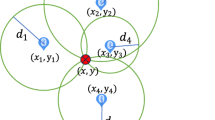Abstract
High localization rigor and low development expense are the keys and pivotal issues in operation and management of wireless sensor network. This paper proposes a neoteric and high efficiency algorithm which is based on new optimization method for locating nodes in an outdoor environment. This new optimization method is non-linear optimization method and is called intelligent water drops (IWDs). It is proposed that the objective function which need to be optimized by using IWDs is the mean squared range error of all neighboring anchor nodes. This paper affirms that received signal strength indicator (RSSI) is used to determine the interior distances between WSNs nodes. IWDs is an elevated performance stochastic global optimization tool that affirms the minimization of objective function, without being trapped into local optima. The proposed algorithm based on IWDs is more attractive to promote elevated localization precision because of a special features that is an easy implementation of IWDs, in addition to non cost of RSSI. Simulation results have approved that the proposed algorithm able to perform better than that of other algorithms based on optimization techniques such as ant colony, genetic algorithm, and particle swarm optimization. This is distinctly appear in some of the evaluation metrics such as localization accuracy and localization rate.








Similar content being viewed by others
References
Singh, S., Shivangna, S., & Mittal, E. (2013). Range based wireless sensor node localization using PSO and BBO and its variants. In 2013 International conference on communication systems and network technologies (pp. 309–315).
Marks, M., & Niewiadomska-Szynkiewicz, E. (2011). Self-adaptive Localization using signal strength measurements. In SENSORCOMM 2011: The fifth international conference on sensor technologies and applications (pp. 73–78).
Jinyu, H., Luo, J., Zhang, Y., Wang, P., & Liu, Y. (2015). Location-based data aggregation in 6LoWPAN. International Journal of Distributed Sensor Networks, 4, 2015.
Xiao, F., Wu, M., Huang, H., Wang, R., & Wang, S. (2012). Novel node localization algorithm based on nonlinear weighting least square for wireless sensor networks. International Journal of Distributed Sensor Networks, 8(11), 1238–1241.
Luo, J., Jinyu, H., Di, W., & Li, R. (2015). Opportunistic routing algorithm for relay node selection in wireless sensor network. IEEE Transactions on Industrial Informatics, 11(1), 112–121.
Luo, J., Di, W., Li, R., & Pan, C. (2015). Optimal energy strategy for node selection and data relay in WSN-based IoT. Mobile Networks and Applications, 20(2), 169–180.
Cao, W., Wang, H., & Liu, L. (2014). An ant colony optimization algorithm for virtual network embedding. In International Conference on Algorithms and Architectures for Parallel Processing (pp. 299–309). Springer International Publishing.
Malhotra, R., Singh, N., & Singh, Y. (2011). Genetic algorithms: Concepts. Design for Optimization of Process Controllers, 4(2), 39–54.
Arampatzis, T., Lygeros J., & Manesis, S. (2005). A survey of applications of wireless sensors and wireless sensor networks. In Proceedings of the 2005 IEEE international symposium on, Mediterrean conference on control and automation intelligent control (pp. 719–724).
Amundson, I., & Koutsoukos, X. (2009). A survey on localization for mobile wireless sensor networks. Mobile entity localization and tracking in GPS-less environments (pp. 235–254).
Mao, G., Fidan, B., & Anderson, B. (2007). Wireless sensor network localization techniques. Computer Networks, 51(10), 2529–2553.
Perillo, M., & Heinzelman, W. (2004). Wireless sensor network protocols. Computer Networks, 52(12), 2292–2330.
Rawat, P., Kamal, S. D., Chaouchi, H., & Bonnin, J. M. (2014). Wireless sensor networks: A survey on recent developments and potential synergies. The Journal of Supercomputing, 68(1), 1–48.
Lu, Y. H., & Zhang, M. (2014). Adaptive mobile anchor localization algorithm based on ant colony optimization in wireless sensor networks. International Journal on Smart Sensing and Intelligent Systems, 7(4), 1943–1961.
Kapil, U., & Gandhi, D. K. (2014). Genetic algorithm for wireless sensor network with localization based techniques. International Journal of Scientific and Research Publications, 4(9), 1–6.
Jacob, L. (2008). Localization in wireless sensor networks using particle swarm optimization. In IET conference proceedings (pp. 227–230).
Zhang, F. (2013). Positioning research for wireless sensor networks based on PSO algorithm. Elektronika Ir Elektrotechnika, 19(9), 7–10.
Chuang, P. (2011). Employing PSO to enhance RSS range-based node localization for wireless sensor networks. Journal of Information Science, 1611, 1597–1611.
Low, K. S., Nguyen, H. A., & Guo, H. (2008). A particle swarm optimization approach for the localization of a wireless sensor network. In 2008 IEEE international symposium on industrial electronics (pp. 1820–1825).
Low, K. S., Nguyen, H. A., & Guo, H. (2008). Optimization of sensor node locations in a wireless sensor network. In 2008 Fourth international conference on natural computation (vol. 5, pp. 286–290).
Kulkarni, R. V., & Venayagamoorthy, G. K. (2011). Particle swarm optimization in wireless-sensor networks: A brief survey. IEEE Transactions on Systems, Man, and Cybernetics, Part C (Applications and Reviews), 41(2), 262–267.
Al Alawi, R. (2011). RSSI based location estimation in wireless sensors networks (pp. 118–122).
Hosseini, H. S. (2007). Problem solving by intelligent water drops. In IEEE Congress on evolutionary computation, Singapore (pp. 3226–3231).
Hosseini, H. S. (2008). Intelligent water drops algorithm: A new optimization method for solving the multiple knapsack problem. International Journal of Intelligent Computing and Cybernetics, 1(2), 193–212.
Shah-Hosseini, H. (2009). The intelligent water drops algorithm: A nature-inspired swarm-based optimization algorithm. International Journal of Bio-Inspired Computation, 1(2), 71–79.
Duan, H., Liu, S., & Lei, X. (2008). Air robot path planning based on intelligent water drops optimization. 2008 IEEE international joint conference on neural networks (IEEE World Congress on Computational Intelligence) (pp. 1397–1401).
Acknowledgements
This work is partially supported by Program for the National Natural Science Foundation of China (61672220).
Author information
Authors and Affiliations
Corresponding author
Rights and permissions
About this article
Cite this article
Gumaida, B.F., Luo, J. Novel localization algorithm for wireless sensor network based on intelligent water drops. Wireless Netw 25, 597–609 (2019). https://doi.org/10.1007/s11276-017-1578-y
Published:
Issue Date:
DOI: https://doi.org/10.1007/s11276-017-1578-y




